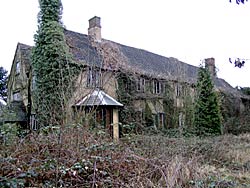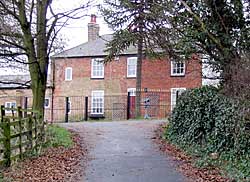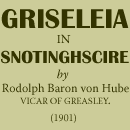< Previous | Contents | Next >
Hemshell

Hempshill Hall, overgrown with creeper and semi-derelict in 2004 (Photo: A Nicholson, 2004).
HEMSHELL also Hempshill, Hemdeshull, and even Hems Hall is in Domesday written Hamessel.
Mr. Edmunds has rather surprised us by his derivation of “Hem.” He wrote that it is a corruption from “Emma,” the mother of Edward the Confessor, and “shel” as coming from “sceol” a shallow place. We do not think that it is necessary to dwell on that. We. prefer “Taylor” who on page 124 of his book derives “hem” from “ham” “a home” and on page 485 “sell “(AngloSaxon) a “cottage.” It would thus mean a “cottage home” and such possibly it may have been before a good house was erected there. The Hamlet is not mentioned in Spelman’s Villare Anglicum. There was according to Domesday in Hemshel soc to Hockenale of six bovats to the geld. The land was one carucate, and there were besides two socmen, and two bordars with two carucates and four acres of small wood. This latter soc lay partly in Bulwell and partly in Watenot, and was William Peverall’s. Some of this belonged to the Parish of Greasley, which had an early Chapel in the place. It was owing to this Chapel that we felt that we must give to Hemshel priority over Kimberley in our history, the Church of the latter place being of a date over 50 years later. To give this difference clearly we gather from the Torre Manuscripts as follows: “ There was a Chapel in this town of Hindeshall, for on the 29th of January, 1240, Walter de Gray, Archbishop of York, confirmed the grant which Hugh Fitz Ralph, patron, and Hugh de Cressy, Rector of the Church of Greselang made to Sir Robert de Vavasour and his heirs, touching the having a chantry in this chappell.” The chantries began to suffer under the spoliation edict of Henry VIII., but if it was not then done away with, it will surely have been so under the Chanteries Act of Edward VI., in 1547, and with it probably the Chapel itself will have been suppressed. We know nnthing more of it after that date. The more considerable part of Hemshel belonged to the Strelleys. It came in the Division to the Sacheverells and was subsequently purchased by the Ascough family, descending from Sir Robert Ayscough in the absence of heirs male, to his daughter Jane, who married Gervas Rosell of Radcliff, Esq., as his second wife. Thoroton mentions another house in Hemshel, with grounds belonging thereto, which was the Willoughby’s of Wollaton, but was in Thoroton’s time the inheritance of the Shepheards.
The part of Hemshel which belonged to Greasley, and which comprises the dwelling house in which Mr. Houghton now lives, remained with the Mother Church of Greasley until the Ecclesiastical District Parish of Kimberley was formed. Another part which also belonged to Greasley was at Cinderhill, and comprised both the Colliery there and also the Cottages which are situate opposite to where the road for Broxtow branches off from the Nottingham road. Both of these, as well as that part of Hemshel which was of Greasley, became included in the new parish of Kimberley. We see from the foregoing that a considerable of Hemshel belonged to the Strelleys, who like many other landed proprietors had taken their name from their chief manor. The name originally was Stralley, also Stradleg Walter de Stradlegh married Isilia, widow of William de Moiz, about the time of Henry I., by whom he had a son named Sampson, who gave account for ten marks of his amercements in the forest.

Cottages to the rear of Hempshill Hall (Photo: A Nicholson, 2004).
We inter alia meet also with Simon de Stradley in Richard I’s. time as having had to suffer on account of having been a partisan of Earl John, afterwards King of England; and there is a curious note, which Thoroton has about a member of a branch of this family, i.e., that, Robert Strelly of Woodborow was in the 9th year of Henry VII. bound in forty shillings by one Simon Digby, Esq., that he should not chevish nor borrow any sum of goods or money of any person, nor bind himself, nor enter into mortgage. The Strelleys of Strelley seem to have lost their importanceif when two sons of a John and Sancia Strelley died young and the estates devolved upon the four remaining daughters, Isabel, wife of Clement Lowe; Margaret, wife of John Pawtrell of Hallam; Elizabeth, wife of William Ayscough, and Ann, wife of Sir Richard Stanhope of Rampton. Only Strelley itself and Bilborough then went to Sir Nicholas Strelley, the younger brother of John, and he died in 1560.
We are able to trace what property the Strelleys had of the Hemshel properties. There was a post mortem inquisition held (vide W. P. W. Phillimore), which took place at Trowell on the 12th of November, 1488, the fourth year of Henry VII., respecting the properties held by Robert Strelley, Knight, then deceased. The Escheator on the occasion was Thomas Hunt, and the jury consisted of the following: John Brunnesley of Trowell, gentleman, Henry Lamyng, of Bilburgh, gentleman, Robert Lamyng, of the same place, gentleman, Richard Skevyngton, of Cossall, gentleman, Nicholas Whiteley of Kymberley, Thomas Wryght, of Bilburgh, Thomas Brounsten, of Trowell, Thomas Burton, of Stapulford, and John Middleton. who on their oath say: “that Robert Strelley, Knight, was seized in his demesne as of fee, on the day he died, of the manor of Strelley and advowson of the Church, 2 oxgangs of land in the town of Strelley; 1 messuage, 3 oxgangs of land and meadow at Bramcote; and 10 oxgangs of land at Hemshel, which last named 10 oxgangs of land were held of the Prior of Beauvale, &c., &c., &c., and that John Strelley, Esq., is the son and heir of Robert Strelley, Esq., and is aged 40 years and upwards.”
The Sacheverels who held property at Hemschel were descendants of the family of that name who had monumental memorials in the Church of Kingston upon Soar, and more of them and in better preserved condition in the Church of St. George at Barton.
The Aescoughs of Hemshel appear to have been descendants of Sir William Ayscough, a judge, who had the moiety of a manor at Basford, which had been the Cockfields, from whom it came to the Taylboys and so descended to the Ayscoughs.
It remained in that family until Sir Roger Ayscough sold it among freeholders. In Throsby’s time Hempshill contained two or three houses and at that time belonged to Lord Wentworth. The Greasley part of Hemshell now belongs to John Holden, of Nuttall Temple, Esq., but ecclesiastically (so far as we as Vicar of the mother parish know) it still belongs to the new Parish of Kimberley and not to Nuttall.
